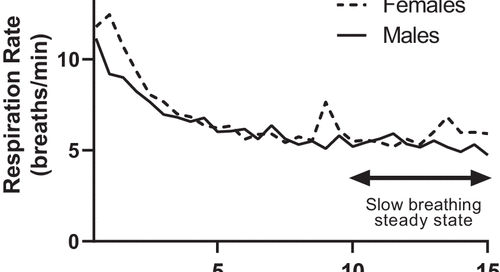Image: Tessa Adler and colleagues (2019)
Slowing breathing down helps us to settle and deal with what the world might be hurling at us.
Some of the positives of slow breathing:
Reducing pain, the physical kind anyway
Reducing distress, such as anxiety and depression
Reducing heart rate, and blood pressure, and increasing both heart rate and blood pressure variability – are all good things in terms of living long and well
Enhancing attention
But how much training is enough? No point spending hours on this right?
I looked at recent studies to find out how they trained their people.
Luciano Bernardi and colleagues got his 23 healthy participants to recite the Ave Maria (‘Hail Mary’, a Catholic prayer), and a Buddhist mantra (om-mam-padme-hum, or, roughly, ‘the jewel in the lotus’), and to do six minutes of ‘controlled breathing’ – that is breathing in and out at the rate of 6 times a minute over 6 minutes. All approaches delivered positive results.
Xiao Ma and his team were a bit more rigorous – people completed 20 sessions of breathing training (each session included 15 minutes of diaphragmatic breathing training) – to get their breathing rate down to 4 breaths/minute. These young healthy participants typically got down to this rate within five sessions, and then maintained this 4 breaths/minute rate over the remaining 15 sessions).
Hassan Jafari targeted the 6 breaths/minute zone and varied the in-breath / out-breath ratio to find which helped his brave participants to best manage pain (“painful heat stimuli”). At this breathing rate, a longer out breath had the best effect (as an example, that could be 4 seconds in, 6 seconds out for a total breath cycle of 10 seconds; over 1 minute that’s 6 breaths).
Some people like the ‘7-in:11-out’ breathing pattern; a similar ratio (7/11 = .64) to 4:6 (4/6 = .67).
Why 6 breaths per minute? Because somewhere between 4.5 to 6.5 breaths/minute most people find the sweet spot of synchronicity between breathing rhythm and heart rate. And, of course, 10 seconds/breath is simple to remember.
It seems from Luciano Bernardi’s experience that six minutes of practice can deliver good results.
Want a free App to help you with that?
· The Breathing App (TBA) can be set at 4:6 (4 in and 6 out) and delivers a helpful tone and visual image at the rate of 6 breaths/minute. At 5:7 it provides a 5 breaths/minute rate.
· Breathe2Relax is a little busy for my taste – but it is possible to separately adjust the timing for the in-breath and the out-breath. Up to a maximum in-breath of 9.4 seconds, out-breath of 16 seconds – that’s close to 2 breaths/minute. Nice to be able to experiment.
I’d appreciate news of any good Apps or approaches to slow breathing that you can share.



